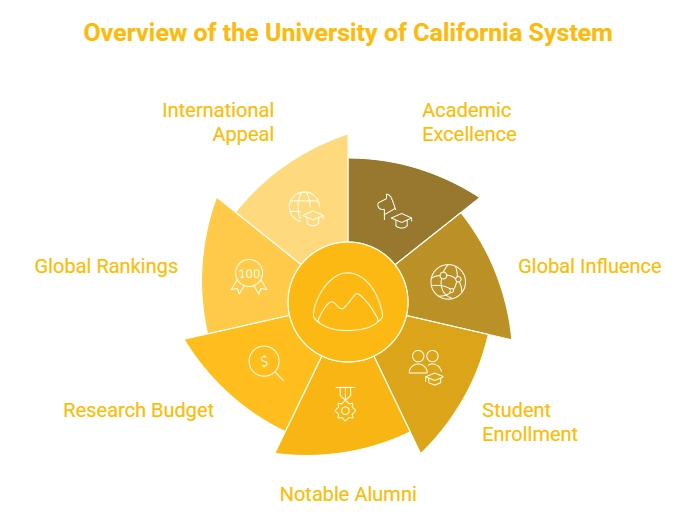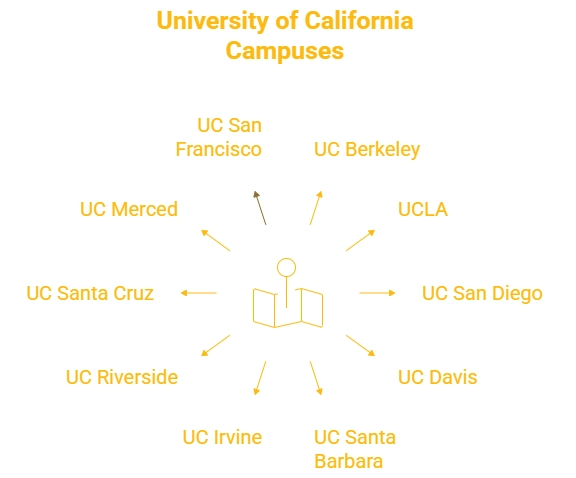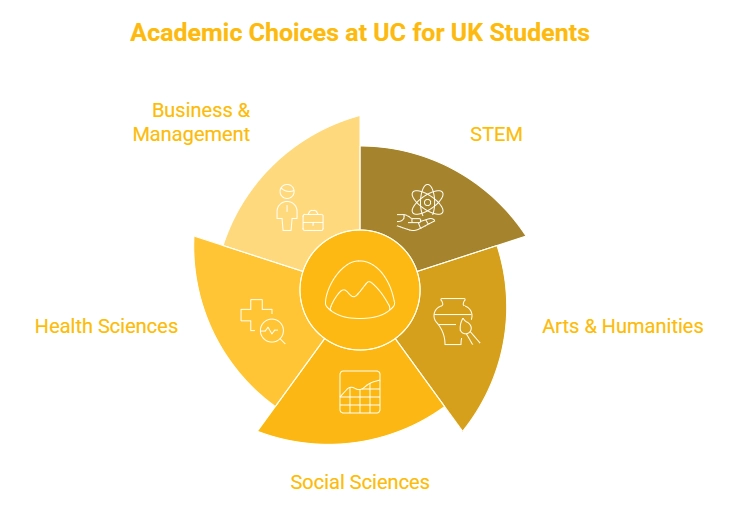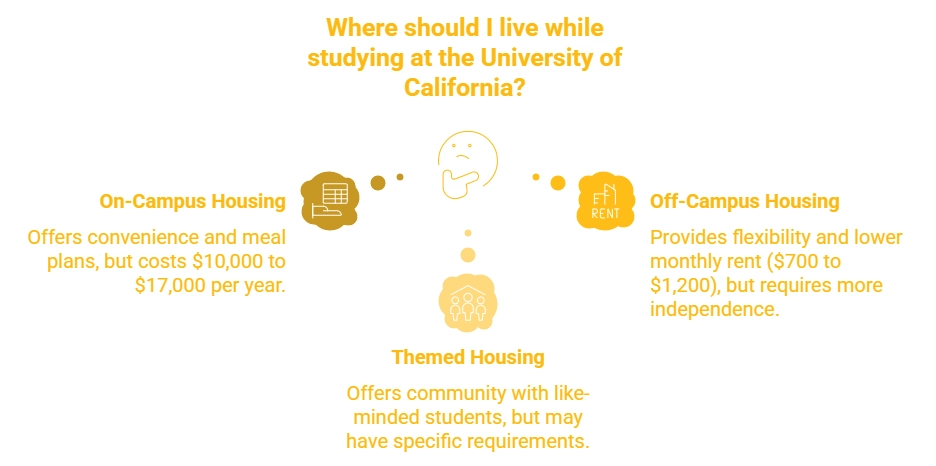As one of the premier public university systems in the U.S., the University Of California (UC) is known for strong academics, innovative research, and worldwide influence. Founded in 1868, the UC system includes ten campuses statewide, each providing high-quality programs.
The UC system draws students from over 100 countries, with increasing numbers from the UK, because of its strong academic standing, many course choices, and attractive California environment.

The University of California system includes 10 campuses:

The University of California comprises ten campuses, each holding its own position in the QS World University Rankings.
| Campus | QS World University Ranking 2025 | Notable Strengths |
| UC Berkeley | #10 | Engineering, Computer Science, Environmental Science |
| UCLA | #29 | Film & Media, Medicine, Law |
| UC San Diego | #62 | Biological Sciences, Oceanography |
| UC Davis | #118 | Agriculture, Veterinary Science |
| UC Santa Barbara | #164 | Physics, Materials Science |
| UC Irvine | #244 | Business, Public Health |
| UC Riverside | #435 | Education, Environmental Studies |
| UC Santa Cruz | #375 | Astronomy, Marine Biology |
| UC Merced | Unranked in QS | Sustainability, Engineering |
| UC San Francisco | Not ranked (graduate only) | Medicine, Pharmacy |
Getting into the University of California might be competitive, especially if you're an international applicant. Each campus has its own acceptance rate.
| Campus | Overall Acceptance Rate | International Acceptance Rate |
| UC Berkeley | 11% | 8% |
| UCLA | 9% | 7% |
| UC San Diego | 34% | 27% |
| UC Davis | 46% | 35% |
| UC Santa Barbara | 29% | 23% |
| UC Irvine | 21% | 15% |
| UC Riverside | 66% | 55% |
| UC Santa Cruz | 47% | 40% |
| UC Merced | 85% | 70% |
The University of California system has a lot of academic options, with over 150 majors for undergrads and more than 500 programs for graduate students. UK students often choose these fields:

Get detailed insights into the tuition costs and available scholarships
| Campus | Annual Tuition for International Undergraduates | Living Costs (Estimated) | Scholarship Options |
| UC Berkeley | $51,000 | $19,000 | Regents’ Scholarship, Berkeley International Student Award |
| UCLA | $48,000 | $21,000 | UCLA Merit Scholarships |
| UC San Diego | $47,000 | $20,000 | Jacobs School Scholarships |
| UC Davis | $47,000 | $18,000 | Global Aggie Award |
| UC Santa Barbara | $47,000 | $18,500 | UCSB International Student Scholarship |
| UC Irvine | $46,000 | $20,500 | UCI Distinguished Scholarships |
| UC Riverside | $46,000 | $18,000 | Chancellor’s International Award |
| UC Santa Cruz | $46,000 | $18,500 | Undergraduate Dean’s Award |
| UC Merced | $44,000 | $17,000 | UC Merced Merit Scholarship |
The University of California system provides various housing choices, both on and off campus.
Many UC schools ensure that international students have housing in their first year.

Step 1: Research UC Campuses and choose up to 5 campuses to apply through the UC Application Portal
Step 2: Prepare academic documents (A-level results, IB scores, or the like).
Step 3: Write four personal insight questions (350 words each).
Step 4: Submit application between November 1 to 30 for the following academic year.
Step 5: Pay the application fee. It’s $80 for each campus if you're an international student.
Step 6: Send extra test scores if needed. SAT/ACT scores aren't required, but you must send English test scores (IELTS/TOEFL).
Step 7: Wait for the admission decision (March–April).
Step 8: If accepted, accept the offer and pay a deposit.
Step 9: Apply for an F-1 student visa.
Step 10: Arrange accommodation and prepare for orientation.
Australia Student Visa
Akshay applied for a Student visa for Au
Read More...
Australia Student Dependent Visa
Sameera applied for a Student visa for A
Read More...
Australia Student Visa
Prashanth Sikhamani came to us as he was
Read More...
Suppose you are not a native English speaker living in the UK or a Permanent Resident of a non-English speaking nation. In that case, you must take the English Language Test (ELT) in Australia as part of your student visa. There are several types of ELT in Australia; you need to choose the correct ELT specified by your university in Australia for the course you are pursuing. Below are the minimum scores required to score for ELTs in Australia.
| English Language Test | Minimum Overall Score |
| IELTS | 5.5 |
| TOEFL | 46 |
| CET | 162 |
| PTE | 42 |
| Occupational English Test | ‘B’ for each test component |
The following are the variations in work permissions and other related differentiations under the Australia Study Visa:-
| Categories of differentiation | Visa (Subclass 485) | Visa (Subclass 500) | Visa (Subclass 590) |
| Cost of Visa | AUD 1730 | AUD 650 | AUD 650 |
| Work Permissions While Studying | Study Visas after April 2008 automatically make you eligible to work:- -For unlimited hours when your course is not in session | ||
| Work Permit After Completing Education | Note that English Language Proficiency courses pursued by international students can’t be used to fulfill Australia Study Visa Requirement.
So these courses can’t be counted for Post Study Work Permit under sub-class 485 |
International student who complete Australian study requirement, are eligible to apply for Post-Study Work Permit under both subclasses. | |
| Exceptions (if any) | In case an international student has been asked to take an English language course as a forerunner to admission to a regular degree/diploma course, the international student must apply for a student visa that is eligible for the main course. | In case the course duration doesn’t match the Australian Study Visa Requirement, the international student can undertake 2 or more programs that will be added to check his/her eligibility for a Post Study Work Permit. | In case your visa expires before you complete your graduation, then as an you can apply for a visitor visa.
You need to provide a letter from your Australian university/ institute that states the upcoming date of your graduation in the course. |
| S. No. | Post-Study Work Visa | Key Features |
| 1. | Skilled-Recognised (Subclass 476) Graduate Visa | Applicable for Engineering graduates |
|
|
| Stay duration up to 18 months |
|
|
| Processing time 8 months to 11 months |
|
|
| Visa cost Starts from AUD 405 |
|
|
| Visa type Temporary |
|
|
| Allows you to bring the family with you |
| 2. | Temporary Graduate Visa (Subclass 485) for Graduate Work Stream | Applicable for recent graduates |
|
|
| Stay duration up to 18 months |
|
|
| Processing time 90 days to 4 months |
|
|
| Visa cost start from AUD 1650 |
|
|
| Visa type is temporary |
|
|
| Allows you to bring your family with you |
| 3. | Temporary Graduate Visa (Subclass 485) for Post-Study Work Stream | Recent graduates from an Australian institution can apply for this visa |
|
|
| Stay duration Between 2 and 4 years |
|
|
| Processing time 70 days to 90 days |
|
|
| Visa cost Starts from AUD 1650 |
|
|
| Visa type Temporary |
|
|
| Allows you to bring the family with you |
If you wish to pursue a Master’s degree in Australia, you can do it by choosing the right kind of subject, degree, and most importantly the university. It will help you enhance your technical skills and give your CV an edge over others.
As an international student from the UK having completed your graduation, you should look for a university where the emphasis is on practical learning, knowledge enhancement, and hands-on work experience. All these will help you become job-ready for the future. Universities in Australia provide you a chance to enhance research-based learning approaches that will allow you to implement any concepts or ideas that you may learn in your classroom.
You can start by looking at the subjects available for post-graduate studies that are in line with your graduation program. You can narrow down your preferred choices as per your academic scores by listing the most relevant ones. You can then look for universities and colleges offering programs covering your preferred subjects.
As a next step you apply to the Australian universities and institutions by taking the language and/or aptitude tests. Once you clear some of the most appropriate ones, it is then up to you to decide where to study. Where to study not only on the subjects you choose but also on fee structure, faculty, college environment, facilities, communication, and safety.
You must also consider which university allows you to work on or off campus to support yourself. After considering all the above choose which will be your preferred course at your preferred university and prepare accordingly.
Yes, your Australia international student visa can be rejected. However, the rejection rate for an international student visa is only between 4-8% in the last few years. If your student visa lacks any kind of information that could have bolstered your student visa claim by proving the claims you mentioned, there is a good chance that your Australian study visa will be rejected.
According to the new student visa rules, visa applicants must now submit a Confirmation of Enrolment (CoE) instead of a Letter of Offer. This change was effective January 2025 and applies to both onshore and offshore student visa applicants.
Some of the other student visa rules that were announced in 2025 are as follows: